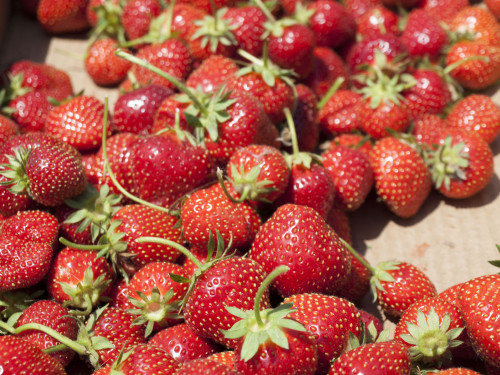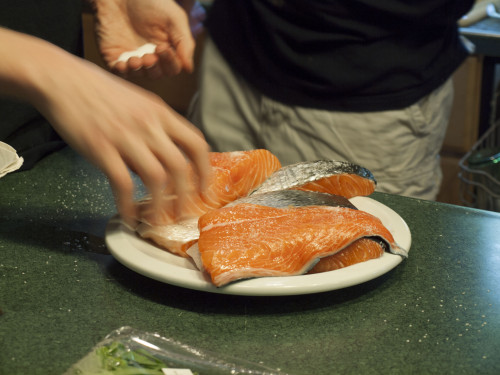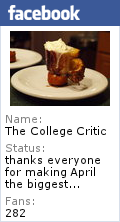 Needless
to say, supermarket strawberries and their fresh-picked counterparts
are of entirely different material: the first, a watery ectoplasm, the
second, a thick honey. In the fields, strawberries grow close to the
ground, buried under their own leaves and hay. Hence the German
word Erdbeeren, or earth-berries. Yet, strawberries taste
more celestial than chthonic; they are a blood spatter of sunlight cast
into fleshy gems. Warmed by the sun, a fresh strawberry looks
translucent and tastes like a heady breath of perfume. In St. Louis, we
pick fist-sized berries, not fragile fraises des bois. Whereas the
biggest supermarket berries often taste the weakest, the most mature
specimens on the farm contain the most concentrated flavor: size does
not signify dilution. We worked for an hour and harvested 15 pounds;
thus far, we have canned eight jars of jam, baked two pies, and churned a
few quarts of ice cream. With berries so sweet, I decided to add Greek
yogurt to the recipe, retaining a few egg yolks for richness. I love the
harsh scrape of strong yogurt against an almost cloying mouthful of
fruit. The following recipe only works with the best, freshest berries,
so be satisfied with pictures if you lack a local strawberry patch. Continue reading
Needless
to say, supermarket strawberries and their fresh-picked counterparts
are of entirely different material: the first, a watery ectoplasm, the
second, a thick honey. In the fields, strawberries grow close to the
ground, buried under their own leaves and hay. Hence the German
word Erdbeeren, or earth-berries. Yet, strawberries taste
more celestial than chthonic; they are a blood spatter of sunlight cast
into fleshy gems. Warmed by the sun, a fresh strawberry looks
translucent and tastes like a heady breath of perfume. In St. Louis, we
pick fist-sized berries, not fragile fraises des bois. Whereas the
biggest supermarket berries often taste the weakest, the most mature
specimens on the farm contain the most concentrated flavor: size does
not signify dilution. We worked for an hour and harvested 15 pounds;
thus far, we have canned eight jars of jam, baked two pies, and churned a
few quarts of ice cream. With berries so sweet, I decided to add Greek
yogurt to the recipe, retaining a few egg yolks for richness. I love the
harsh scrape of strong yogurt against an almost cloying mouthful of
fruit. The following recipe only works with the best, freshest berries,
so be satisfied with pictures if you lack a local strawberry patch. Continue reading
Category Archives: St. Louis
Strawberry Greek Yogurt Ice Cream
Orzo Salad with Olives, Mushrooms, Raisins, and Sunflower Seeds
Despite the muggy weather and relative absence of olive groves, I like cooking with Mediterranean intent when I’m home from school. I’ll spin some Grateful Dead, decompress, and put a yellow onion on mellow simmer. Without the usual time constraints of college cooking, I can tinker with technique and ingredient proportion. For example, I enjoy working with salmon, but have struggled on previous attempts to achieve pork-cracklin-crisp skin. Thursday night, I let the cast iron pan reach truly incendiary temperatures before laying down a fillet. The skin tightened into a sheet of pure crunch. I served the salmon over an orzo salad—I mixed a stew of onion, raisins, sunflower seeds, mushrooms, and olives with the warm pasta. If cooking fish is a matter of precision, pasta salad is an issue of instinct. Be careful seasoning the salad, because its individual components already contain salt. I thought about adding anchovies or anchovy paste, too, but alas, the cupboard was lacking any little fishes. No lies: I have no emotional connection or special interest in the following recipe. It just tastes good, which ought to be argument enough. Continue reading
Filed under College Life, Columbia University, Recipes, St. Louis
Gioia’s Deli Chases Trend, Swallows Tail
Gioia’s Deli has a blog. It’s sleek, attractive—more visually appealing than this blog in fact!—and seductive: “Psssst. . .Psst. . .Hey you. Gioia’s wants to hook you up. Join our Mailing List to receive great deals on great food. Just click the picture. Ssshhhh, don’t tell anyone its a secret [sic].” Besides “Al’s Blog,” which so far has detailed “The Gioia’s Deli Philosophy” (1/18/12), “A Day in the Life of a Boxed Lunch” (1/14/12), “Gioias is the Healthiest Option on The Hill” (1/3/12), and “What to get a foodie” (12/1/11), the website offers a “Gallery of Deliciousness.” Unable to resist, I clicked the link and browsed a collection of food porn thumbnails—no amateur shoots, only AVN quality stuff here. Clearly, Gioia’s has decided to bring the business into the 21st century; the deli’s streamlined web presence speaks to any number of contemporary restaurant trends, most obviously, foodie-ism and nutritionism. The desire to capture new market niches would not be so surprising if Gioia’s had not occupied the same plot at Macklind and Daggett for 94 years. Challie Gioia started a grocery there in 1918, and since 1980, the Donley family has operated the store as a deli. At the original grocery, Steve and Johnnie Gioia served “Salam de Testa” to the lunch crowd. Today, the Donleys call the Gioia recipe “Hot Salami”—they serve it on chewy blonde bread, and it has attracted attention from St. Louis foodie rags like Feast. The “Hot Salami” is an excellent sandwich and deserves all the praise it has received. Nevertheless, the disconnect between Gioia’s web identity and its physical reality is disconcerting. Continue reading
Filed under Restaurants, St. Louis, Theory and Criticism
Notes From America: Biscuits and Gravy In The Olivette Diner During A Snowstorm
Two skinny cooks, backwards baseball caps and shriveled biceps, split buttermilk biscuits, fry them on the flattop, and slop them on fake china. Thick glutinous gravy ladled over biscuits: medicinal when taken beyond the brunch hour. Nevermind the inch of snow shutting down St. Louis County—I hunkered down in the Olivette Diner, drinking coffee, eating fatty ham, safe from white collar traffic. My biscuits cost three dollars, a cheap prescription for comfort. A perceptible layer of grease coats everything in the diner, from teal vinyl seats to the saltshakers. Once called the Riteway, “the Diner”—as I have always known it—lays a small claim on history. Head East, “the Midwest’s Legendary Classic Rock Band,” photographed the back cover of Flat as a Pancake behind the counter. The album’s front, of course, depicts a beautifully browned pancake complete with melting butter pat and maple syrup. I wolfed down BLTs three decades after the diner’s Riteway days, but the menus, manual cash register, and malteds cling to past allure—not during long thin days (of construction workers eating hash and lonely business lunches), but at night, hot September nights after soccer games in the park, after the roar of mosquitos drowned out sneakers scuffling on dry grass. Continue reading
Filed under Restaurants, St. Louis, Theory and Criticism
I Can’t Believe It’s Not Goody Goody
“Are we that conspicuous?”
We are walking around the Goody Goody Diner, looking for the entrance. On a warm January morning—thin blue sky, no breeze, sun like unsalted butter—the parking lot looks half-full. A man wearing a red apron chats into an open car, smoking, on break.
“It’s around that way—” he points, smiling and squinting. I start wandering between cars, completing one full lap around the diner to find the door. My brother, Zach, follows, camera slung over shoulder, but my mom pauses. In a strained, uncomfortable voice, she laughs—forcing breath out through the nose and teeth with a tightening around the lips. (Having inherited this habit, I understand its mechanics well.)
“First time here?” The cook asks, and I call back over my shoulder “Yeah,” but my mom slows, laughs, stands for an obvious millisecond.
“Are we that conspicuous?” She says. We are indeed that conspicuous—because she carries a black Kate Spade bag, because despite my Einsteinian tangle of hair and half-shaven cheeks and defeated corduroy coat I wear jeans washed in a certain dark blue/black dye not available at So Flyy Hair Gallery and Mr. Fish—because we are white and walking around Pine Lawn (St. Louis suburb, 95.96% African American, 36.9% below the poverty line). Of course, we also look lost and confused and hungry and in need of assistance. But we mainly look like we don’t belong here, on Natural Bridge Avenue, down the street from Hair Graphics and Princess Beauty Supply and Fashions, Reynolds’ Bar-B-Que, and a lineup of empty nightclubs. Continue reading
Filed under Essays, Restaurants, St. Louis, Theory and Criticism
In Search of Lost Steakburgers
This summer, I took a class on “Reading and Writing Food” at Columbia. Over the next few weeks, I will post a sampling of essays composed for that class.
note 7/12/11: Steak ‘n Shake is coming to New York! Read about it here.
In Search of Lost Steakburgers
“I was twelve going on thirteen when I first saw a dead human being. It happened in 1960, a long time ago. . .although sometimes it doesn’t seem that long to me.” —Stephen King, “The Body”
When Dan the Manager got busted on a coke binge, the Steak ‘n Shake gang wasn’t surprised. We had all left St. Louis after high school; I was living in New York, Josh in Virginia, Jack in North Carolina. Over vacations we visited our adolescent haunt, sipping watery milkshakes and polishing off bowls of bright red chili. Yet, even a steakburger—topped with guacamole and chopped onions and pepperjack cheese—couldn’t bring back the Indian summer of our teenage years. First, our favorite waitress, Shannon, quit and went to college at Northeast Missouri State. Tani’qua got fired and works at Walmart. Sean disappeared, too—he once banged a Mexican gangster’s girlfriend and narrowly escaped drugland execution. Or so he said. But Dan was always around with a grin twitching under his pederastic mustache and a joke to lighten the burden of time unregained. Continue reading
Chez Leon: An All-Inclusive French Cuisine Resort in Clayton
by Netta Sadovsky, Washington University
Chez Leon, a spacious French restaurant in Clayton, has a constructed sort of comfort, like a spa. I felt oddly welcome, whether securing a reservation from a man with a sultry, radio-ready voice or leaving to a warm “please come again” from several members of the staff as they lifted their drinks in my direction from the bar. Over the course of the meal three different servers made (non-annoying) conversation about school, the Roquefort, the almond cake, and the book I was reading. I’m sure that had to do with how conspicuous I looked (sitting alone with some books and a camera) but I felt that the staff’s warmth went above and beyond. Continue reading
Filed under Netta S., Restaurants, Reviews, St. Louis, Washington University





